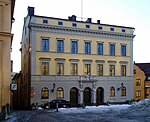Finska Kyrkogränd

Finska Kyrkogränd (Swedish: "Finnish Church Alley") is a blind alley in Gamla stan, an old town in central Stockholm, Sweden. Leading south from Slottsbacken, the alley separates the Finnish Church from the Tessin Palace. It was also named after the vicinity to the former. It forms a parallel street to Bollhusgränd and Källargränd. The alley, for long the property of the Crown, used to lead to Trädgårdsgatan. It was excepted from a land donation in 1648 for the construction of the Lilla Bollhuset ("Small Ball House"), a building originally intended for ball games but mostly used for theatre. This latter building was rebuilt into the Finnish Church in 1725, and as the Finnish parish later enlarged the building, the alley became a blind alley periodically completely sealed off.
Excerpt from the Wikipedia article Finska Kyrkogränd (License: CC BY-SA 3.0, Authors, Images).Finska Kyrkogränd
Finska Kyrkogränd, Stockholm Gamla stan (Södermalms stadsdelsområde)
Geographical coordinates (GPS) Address Website Nearby Places Show on map
Geographical coordinates (GPS)
| Latitude | Longitude |
|---|---|
| N 59.325638888889 ° | E 18.072583333333 ° |
Address
Finska kyrkan
Finska Kyrkogränd
111 31 Stockholm, Gamla stan (Södermalms stadsdelsområde)
Sweden
Open on Google Maps










